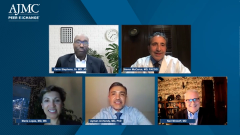
The Patient Journey in Endometriosis
Dr Steven McCarus discusses the journey of a patient with endometriosis through the health care system.
Episodes in this series

Ayman Al-Hendy, MD, PhD: I’m a big fan of medical noninvasive therapy and leaving surgery as a last resort. I see a lot of patients with fibroid or endometriosis who come to me and say, “The only thing I was offered is hysterectomy, and nobody discussed with me all these medical options.” We’re trying to empower the patient through the patient advocacy group, community awareness, and all that. But I wish the Marias and Kevins of the world could come up with a happy medium. Not to override the doctor’s decision, which hopefully came after counseling and discussing with their patients, but to also deal with the situation where not all the options are being offered to the patients, especially some of the newer noninvasive options. I don’t know what that is, but hopefully smarter people like Maria and Kevin can come up with that.
Neil Minkoff, MD: I don’t know what it is either, but it raises a question that I’d like to throw out to Ayman and Steve. As people who are a little closer to the diagnostic journey—if I’m wrong, tell me I’m wrong—my understanding is that getting a definitive diagnosis for something like a fibroid or especially endometriosis can take years. It can take a half a decade or something like that. What’s the patient journey like? Is there anything we could do on the clinical or payer side to try to truncate that journey so it’s not a half a dozen years of suffering and we can get them moving through the system more appropriately?
Steven McCarus, MD, FACOG: Here’s the reality. There’s a lot of misinformation on both sides, with the patient and medical care provider. Payers have a great opportunity to educate their members about endometriosis. We know that women are the health care decision-makers in the family. We all agree on that, right? If you think about it, there are patients who are afraid to talk about their pain who have painful menstruation. They don’t want to mention it. They don’t want to talk about it because of what their mother or friends have told them: “Just live with it and suck it up.”
At the same time, the clinician has to understand that this is a prevalent disease. There are over 6.5 million women in the United States with endometriosis. It’s 1 in 10 patients they see with pelvic pain. The symptoms are moderate to severe in the majority of patients we see with early stage disease. That means, if I take a decent history, 85% of women with endometriosis miss work to some degree, 60% of women can’t complete college or their education because of the disease, and 45% of women complain of sexuality and taking care of their kids and family because of endometriosis. It’s not that hard with the information we have now, a thorough history, and a pelvic exam.
If the pelvic exam is normal, ultrasound isn’t going to be helpful, as Ayman said earlier. It doesn’t pick it up. That’s where we’ve got to decide. We’re going to talk about that in a bit. What’s the best medical choice for a patient with a negative pelvic exam and a history that suggests endometriosis? How can we fast-track that time? Because you’re right. There are data that say it can take up to a decade to diagnose and treat endometriosis. That’s the fault of both parties. It takes the patient about 4½ years to get to the provider, and it takes the provider another 4½ years to properly find the medication or surgery that’s going to help the patient.
My point is that there are so much data around endometriosis. It’s been studied extensively. Ayman just said he found that there are some issues with vitamin intake. There are so much data around this disease. The problem is it’s overwhelming. It’s too much for a payer to get involved with. We should create a task force and build out some algorithms, look at the information, and get a treatment care plan. We can make a difference because it’s an important issue in women’s health.
If you treat it early and get the symptoms under control, you eliminate the issue—not 100%, but to a certain degree, which Dr Lopes was talking about. Endometriosis has a strong relationship with infertility, requiring assisted reproductive technologies and all the cost associated with that. We’re missing the forest for the trees, in my opinion. The journey is difficult. Patients have multiple medications and surgeries and still have an 18% chance of being on opioids for treating their pain, which then becomes a substance abuse issue. There’s a lot of work to be done. I hope this format with your organization will allow us to come together and figure out how we can improve what we’re doing.
Transcripts edited for clarity.
Newsletter
Stay ahead of policy, cost, and value—subscribe to AJMC for expert insights at the intersection of clinical care and health economics.









































